Darcy Pinotti photo
So...just where was this duck hiding on Thursday when the Tofte II group was looking all over the Grand Marais harbor for it?! After all, it had been right there by the Coast Guard station posing for pictures for the Tofte I group – after Joanne saw it fly in while the rest of the group had been scouring the rocks at Artists Point. And, of course, it reappeared on Friday while the Tofte II bunch was elsewhere, birding its way from Tofte back to Two Harbors. Argh!
At least it was some consolation when the Tofte II MBWers claimed a total of 58 species on Thursday-Friday, 3 more than the Monday-Tuesday group. This improvement was partly due to some scouting of sites on Tofte I, to twice as many pairs of eyes to find things on Tofte II (14 participants vs 7), and to the dark skies and rainy weather on Monday morning for the start of Tofte I. Birds of note on Tofte II that were missed on Tofte I were those 2 Bohemian Waxwings at our first stop at Tofte Park; a Northern Shrike, Boreal Chickadee (seen by Mary G), and Western Meadowlark at Taconite Harbor; and a juvenile Ross’s Goose plus Bonaparte’s Gulls in Two Harbors.
Aside from that Harlequin, Tofte I had some other noteworthy finds that the latter group missed: a Canvasback at Castle Danger (pretty rare NE of Duluth), late Wilson’s Snipes and Rusty Blackbirds at Lutsen’s sewage ponds, and a surprising Red-bellied Woodpecker way up by Colvill. Both MBW groups managed to see Cackling Geese, White-winged Scoters at Taconite Harbor (also in Grand Marais on II), Long-tailed Ducks (but very few of them), Red-necked Grebes, Merlins, and both kinglets. Conversely and oddly, though, the following were scarce to nonexistent on both MBWs: Surf and Black scoters, Common Goldeneye, raptors other than Bald Eagle (so where were the Rough-leggeds?), waxwings, winter finches, Snow Buntings, and late-lingering sparrows and warblers.
Thanks to all for coming – especially Joanne and Jocelyn who were on their first-ever MBWs, and to Craig who helped guide the Tofte II group. (Though, of course, it was all his fault for not turning up that Harlequin. On the other hand, though, it was all my fault for not scheduling Tofte II to include Oct 29 – see photo below!)
Bird List (composite total = 76 species)
• Tofte I = 55 species (including 18 not seen on Tofte II)
- Oct 24: from Tofte to Hovland (all in Cook County)
- Oct 25: Fr. Baraga’s Cross & Taconite Harbor (Cook Co), and from Tettegouche to
Two Harbors (Lake Co)
• Tofte II = 58 species (including 21 not seen on Tofte I)
- Oct 27: from Tofte to Grand Portage (all in Cook County)
- Oct 28: Taconite Harbor (Cook Co), and from Tettegouche to Two Harbors (Lake Co)
Snow Goose
Ross’s Goose (II only)
Cackling Goose
Canada Goose
Blue-winged Teal (I only)
American Wigeon (I only)
Mallard
American Black Duck (II only)
Green-winged Teal
Canvasback (I only)
Redhead
Ring-necked Duck (I only)
Greater Scaup (I only)
Lesser Scaup (I only)
Harlequin Duck (I only)
White-winged Scoter
Long-tailed Duck
Bufflehead
Common Goldeneye (II only)
Common Merganser
Red-breasted Merganser
Ruffed Grouse (I only)
Horned Grebe (I only)
Red-necked Grebe
Rock Pigeon
Mourning Dove
American Coot (II only)
Wilson’s Snipe (I only)
Bonaparte’s Gull (II only)
Ring-billed Gull
Herring Gull
Common Loon (II only)
Northern Harrier (II only)
Sharp-shinned Hawk (II only)
Bald Eagle
Red-tailed Hawk (II only)
Red-bellied Woodpecker (I only)
Downy Woodpecker
Hairy Woodpecker
Pileated Woodpecker (II only)
Merlin
Northern Shrike (II only)
Blue Jay
American Crow
Common Raven
Black-capped Chickadee
Boreal Chickadee (II only)
Horned Lark
Ruby-crowned Kinglet
Golden-crowned Kinglet
Bohemian Waxwing (II only)
Red-breasted Nuthatch
White-breasted Nuthatch
Brown Creeper (I only)
European Starling (II only)
Eastern Bluebird (I only)
American Robin
American Pipit
American Goldfinch (II only)
Lapland Longspur
Snow Bunting
Chipping Sparrow (I only)
Fox Sparrow (I only)
American Tree Sparrow
Dark-eyed Junco
White-crowned Sparrow (II only)
White-throated Sparrow
Savannah Sparrow (I only)
Song Sparrow (II only)
Swamp Sparrow (II only)
Western Meadowlark (II only)
Red-winged Blackbird (II only)
Orange-crowned Warbler (II only)
Rusty Blackbird (I only)
Palm Warbler (I only)
Yellow-rumped Warbler
* * *
2022 Tofte I and Tofte II MBWs Summary
October 24-25 and October 27-28
* * *
TOFTE I and TOFTE II MBWeekends Summary
November 2-3 and November 4-5, 2023
Although we’ve literally been doing this late fall MBWeekend up the North Shore for decades, it’s only in the last few years that we’ve based ourselves in Tofte. Previously, we always started in Duluth on the first morning, stayed that night in Grand Marais, and returned the next afternoon to Duluth to retrieve cars and head home. But I think it works better to have Tofte as our base both nights. For one thing, it’s easier not to check in and out of places each night; for another, starting in Tofte gives us time to bird Grand Portage and other places beyond Grand Marais. So, that begs the question: Why didn’t we think of doing it this way about 38 years ago?
We did make it up to Grand Portage on Tofte I, but not so on Tofte II – we were running late then, east winds blew in some snow showers and poor visibility, and, besides, there wasn’t a whole lot there on Tofte I. So, Grand Portage didn’t really account for the difference in our two MBWs, during which Tofte I recorded 67 species, 9 more than Tofte II’s 58, as our two MBWs combined came up with a respectable total of 75 species. (Almost of these were in Cook County, with just a few marked below as only found in Lake Co.)
The big difference between Tofte I and II during our times along the North Shore was the weather, always the most important variable when birding during migration. West winds which are conducive to stirring up migrants here predominated during Tofte I, while east winds and mostly overcast conditions prevailed on Tofte II. Accordingly, the White-winged Scoter, Common Loons, those two Townsend’s Solitaires (Lutsen Sea Villas & Lutsen Resort), Lapland Longspurs, that meadowlark, and three warbler species (including a male Wilson’s!), we turned up on I could not be relocated on II.
But Tofte II did have Ross’s Geese in Two Harbors, Trumpeter Swans in Grand Marias (a rarity in Cook Co.), Wilson’s Snipe, and Rough-legged Hawk – which were all missed on Tofte I. And Tofte II recorded (as did Tofte I): Cackling Geese, Long-tailed Ducks, 2 very late Dunlins (only 1 on Tofte I), Merlins, nice looks at Bohemian Waxwings (there were more on II), a late Gray Catbird, perched redpolls and fly-over Red Crossbills, lots of Snow Buntings (more on I, when Craig counted nearly 700 of them), late Fox Sparrows, and Rusty Blackbirds.
And then there was our incredible luck up on The Grade north of Tofte on Friday morning, when we had 3 Spruce Grouse standing in the road, two Am. Three-toed Woodpeckers in the same place as the grouse (one seen plus another heard), and a mostly cooperative Boreal Chickadee not that much farther up the road! But, alas, none of these would reappear two mornings later for the Tofte II group, though at least they had a Black-backed Woodpecker (not seen there on I, though some on I saw one in Grand Marais), and both groups found panhandling Canada Jays along with good views of Red Crossbills.
Thanks to all of you for coming on this pair of interesting and successful MBWs – it was especially good to see Lonnie from New Mexico again (after 15 years she says, or was it more like 38?). Thanks as well to all the photographers for sharing their images, and, of course, thanks to Craig – the future CEO of MBW, Inc., once he decides to increase his measly offer of $2.8 million to buy the company. –KRE
Bird List
• I = Tofte I, November 2-3
• II = Tofte II, November 4-5
• (L) = seen only in Lake Co.
Ross’s Goose II (L)
Cackling Goose I, II
Canada Goose I, II
Trumpeter Swan II
Mallard I, II
American Black Duck I
Redhead I
Lesser Scaup I, II
White-winged Scoter I
Long-tailed Duck I, II
Bufflehead I, II
Common Goldeneye I, II
Hooded Merganser II
Common Merganser I, II
Red-breasted Merganser I, II
Ruffed Grouse I (L), II
Spruce Grouse I
Horned Grebe I, II
Red-necked Grebe I, II
Rock Pigeon I, II
Mourning Dove I, II
American Coot I, II
Dunlin I, II
Wilson’s Snipe II
Ring-billed Gull I, II
Herring Gull I, II
Common Loon I
Bald Eagle I, II
Red-tailed Hawk I (L)
Rough-legged Hawk II
Belted Kingfisher I
American Three-toed Woodpecker I
Black-backed Woodpecker I, II
Downy Woodpecker I, II
Hairy Woodpecker I, II
Pileated Woodpecker I, II
American Kestrel II (L)
Merlin I, II
Northern Shrike I
Canada Jay I, II
Blue Jay I, II
American Crow I, II
Common Raven I, II
Black-capped Chickadee I, II
Boreal Chickadee I
Horned Lark I, II
Bohemian Waxwing I, II
Cedar Waxwing I, II
Red-breasted Nuthatch I, II
Brown Creeper II
Gray Catbird I, II
European Starling I, II
Townsend’s Solitaire I
American Robin I, II
House Sparrow I, II
Common Redpoll I, II
Red Crossbill I, II
White-winged Crossbill I
Pine Siskin I, II
American Goldfinch I, II
Lapland Longspur I
Snow Bunting I, II
Fox Sparrow I (L), II
American Tree Sparrow I, II
Dark-eyed Junco I, II
White-crowned Sparrow I, II
White-throated Sparrow I, II
meadowlark, sp. (probably Western) I
Red-winged Blackbird I, II
Rusty Blackbird I, II
Common Grackle I, II
Orange-crowned Warbler I
Yellow-rumped Warbler I
Wilson’s Warbler I
Northern Cardinal II
2023 PHOTO GALLERY

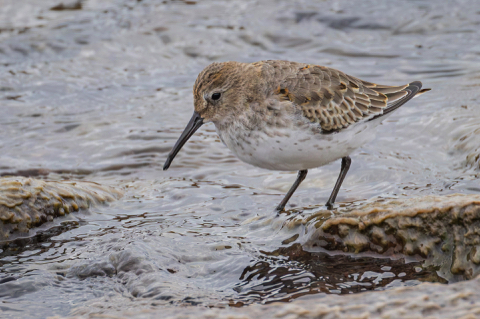
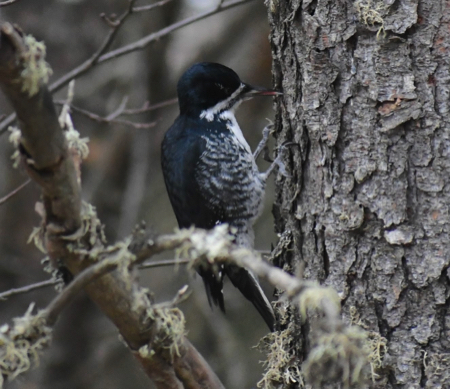
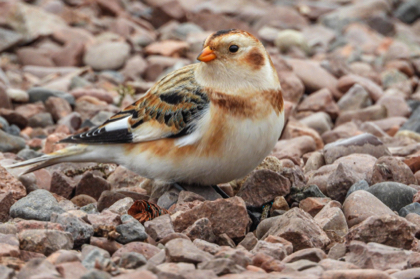
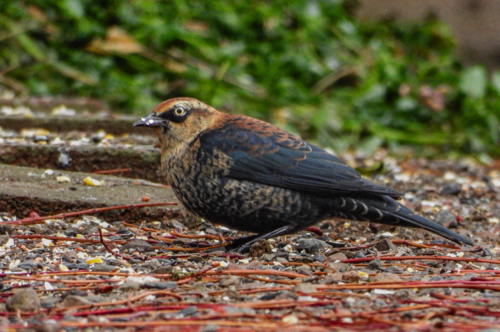
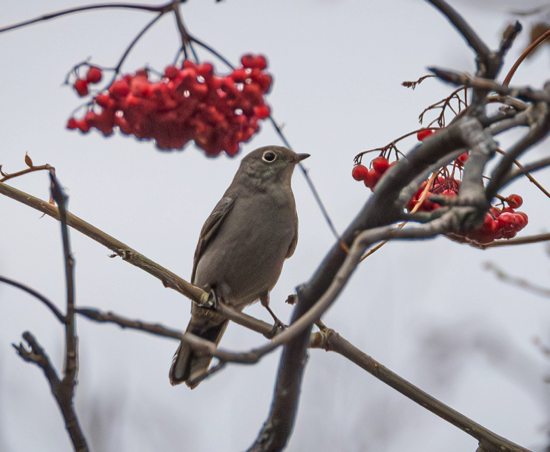
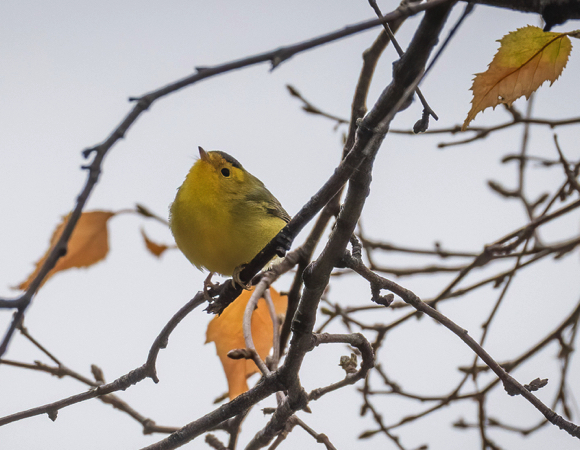
Matt Schaut photo ~ Tofte II
Matt Schaut photo ~ Tofte II
Mariann Cyr photo ~ Tofte I
Mariann Cyr photo ~ Tofte I
Matt Schaut photo ~ Tofte II
Mariann Cyr photo ~ Tofte I
Rose Shea photo ~ Tofte I
Rose Shea photo ~ Tofte I
Found by Michael Sack
& Molly Misfeldt on the
North Shore – one day after
Tofte II ended! (KRE photo)
Mariann Cyr photo ~ Tofte I
See the summaries of the 2023 & 2022 Tofte MBWs
following the 2024 summary.
__________
TOFTE I and TOFTE II MBWs SUMMARY
October 31 - November 1 & November 2 - 3, 2024
Composite Bird List = 78 species
- Cook County = 62 species
- Lake County = 35 species
- Park Point, Duluth on Tofte II incl 2 scoters not seen in C or L
• I = Tofte I MBW, Oct 31 - Nov 1 (57 species)
• II = Tofte II MBW, Nov 2 - Nov 3 (53 species)
Cackling Goose II (Grand Marais)
Canada Goose I
Trumpeter Swan I II
Mallard I II
American Black Duck II
Northern Pintail I (Fr. Baraga’s Cross)
Green-winged Teal I II
Canvasback II
Redhead II (Park Point)
Ring-necked Duck II
Greater Scaup II (Grand Portage & Park Point)
Lesser Scaup II
Harlequin Duck II (Bayside Park in Silver Bay)
Surf Scoter II (Park Point)
White-winged Scoter I II (Taconite Harbor & Park Point)
Black Scoter II (Park Point)
Long-tailed Duck I II (Lutsen, Taconite Harbor, Park Point)
Bufflehead I II
Common Goldeneye II
Hooded Merganser I
Common Merganser I II
Red-breasted Merganser I II
Wild Turkey II (4 along Hwy 61 just SW of Cascade Lodge)
Ruffed Grouse I
Spruce Grouse I II (on The Grade, east of the Sawbill Tr; 1 on I, 3 on II)
Horned Grebe I
Red-necked Grebe I II
Rock Pigeon I II
Mourning Dove
Dunlin II (Beaver Bay sewage ponds)
Wilson’s Snipe I II
Ring-billed Gull I II
Herring Gul I II
Common Loon I II
Bald Eagle I II
Rough-legged Hawk I II
Great Gray Owl II (Sawbill Tr, just south of The Grade)
Red-bellied Woodpecker I
Yellow-bellied Sapsucker I
Black-backed Woodpecker I II (Grand Marais campground on I; The Grade on II)
Downy Woodpecker I II
Hairy Woodpecker I II
Northern Flicker I
Pileated Woodpecker I II
Merlin II
Blue-headed Vireo II (very late migrant in Grand Marais campground)
Red-eyed Vireo II (also very late at Cascade Lodge)
Northern Shrike I (Lutsen)
Canada Jay I II
Blue Jay I II
American Crow I II
Common Raven I II
Black-capped Chickadee I II
Horned Lark I
Bohemian Waxwing I (only 1: along 10th Ave W in Grand Marais)
Cedar Waxwing I
Red-breasted Nuthatch I II
White-breasted Nuthatch II
European Starling I
Eastern Bluebird I
Hermit Thrush I II
American Robin I II
House Sparrow I II
Eurasian Tree Sparrow I (continuing with House Sparrows in Two Harbors)
Evening Grosbeak I (heard by a few in Tofte)
Purple Finch I
Red Crossbill I (fly-overs on The Grade)
Pine Siskin I
American Goldfinch I
Lapland Longspur I
Snow Bunting I II
American Tree Sparrow II
Dark-eyed Junco I
White-crowned Sparrow I
meadowlark, sp. (probably all Westerns) I II (total of 20 on I: 12 in Cook + 8 in Lake)
Red-winged Blackbird I II
Common Grackle I
Summer Tanager II (adult male at Sannes Rd feeder SW of Two Harbors)

MBW Narrative Summary...and Junior Tour Leader Soliloquy
– John Quinn (with minor edits by KRE)
Tofte I, Thursday – Too many cooks in the kitchen
Nothing scary about the day except that once again the weather was not favorable for birding. The dark bleu Ford F150 Crew Cab with John, Sharon, and Craig brought up the rear as we followed Kim out of the parking lot of the AmericInn in Tofte. We started with Tofte Park: one Rough-legged Hawk flew over, and we added the usual suspects, including Pine Siskin. Less expected was a single call note of an Evening Grosbeak heard by Joel and a few others.
Above the former Lutsen Lodge, three of the many meadowlarks we would see over the four days flew from the field to trees. Only once during the trip did I hear one of them “chuck” to positively identify it as Western, and we were educated on why most (possibly all?) are probably Westerns. I missed the Northern Shrike teed up in the poplar tree (or was it a Pine Tree?) for the rest of the group, as I wandered deep into the old cedar grove on the west side looking for owls. I had a nice walk in the woods.
By 10:15 we were at Cascade Lodge. I longed to walk some of the trails higher up. Leadership decreed we must get to Grand Marias. And of course they were right. We spread out in the campground. A Black-backed Woodpecker perched for several minutes in the trees along the shoreline. Two vehicles drove through Grand Marias while others stopped for lunch. At or near the 10th Avenue feeders we added Bohemian Waxwing, Common Grackle, and Red-bellied Woodpecker to the day list. Driving over to where a Scissor-tailed Flycatcher had been found last Sunday, some spotted a “magpie” instead. We jumped out of the cars to get better looks. Hurrying around the corner anxious to add a new bird to several county lists, we discovered a partial-albino crow instead.
A report with photo of a real magpie along CR 69 was received, so we drove east to the location. Abruptly, my JTL position was challenged. Lynn spotted a Ruffed Grouse just off the road, Kim dropped the not-too-subtle hint that Tom R. had saved the day with his recording to lure in the Black-backed Woodpecker, and Val had spotted our only Bohemian Waxwing. My contribution that morning had been to observe the Fika coffee shop wasn’t open. I needed to double down or suffer humiliation. Too many cooks in this kitchen!
Our next stop was Chicago Bay, in Cook County, in Minnesota. Chicago, in Cook County, in Illinois has many harbors, beaches, piers, and a cana,l but no bays. I’d say we’re Superior. Kim’s quiz question would lead to my phase one of my nighttime research project:
- Cook County in IL is the US’s second most populous county after Los Angeles.
- Don’t confuse this Cook with the city of Cook, which is in St. Louis County.
- Originally, Cook County was supposed to be named Vérendrye. Brush up on your French,
my friends. Now I'm cooking.
Tofte I, Friday – Waking up on all fours
I crawled out of bed early trying to hear the Great Horned Owl from the morning before. No luck. I was beginning to doubt my ears. I had spent the previous evening researching the following:
- Four “Trails” off Hwy 61 (which are actually Cook county roads): Sawbill (Tofte), Caribou (Lutsen) Gunflint (Grand Marais), and Arrowhead (Hovland).
- Four Counties without sewage ponds: Another Kim quiz: Fillmore, Olmsted, Ramsey, Washington. (For those of you interested in further research, may I suggest https://mnatlas.org/resources/wastewater-facilities. Or read the Damn Book.)
- Four Counties without natural lakes: Olmsted, Mower, Pipestone, Rock. (Bonus round: What Minnesota county has the most lakes, 1,048 of them? Indeed, has the most in the entire US.)
- Four Owls I’d most like to see in Cook County (if I wasn’t spending time on all this trivia): Boreal, Great Gray, Northern Saw-whet, Northern Hawk Owl.
We met pre-sunrise at 7:00 to head north up the Sawbill Trail in pursuit of Spruce Grouse. We stopped and listened for owls along the way without success. As we came to the corner a truck with three grouse hunters and two dogs were exiting their vehicle. We turned east and stopped about a quarter mile away. Little did they know that as Joel and I wandered away from the group, listening for Black-backed Woodpeckers, Joel would look to his right and 100 feet away was a male Spruce Grouse gritting on a driveway. Thankfully, they tend to be rather tame, and several pictures were taken before it wandered into the woods. We did not report it back to the hunting party.
After finding begging Canada Jays and some fly-over Red Crossbills as well, we returned to Tofte, packed up, and headed for Two Harbors in Lake County via multiple stops on the way. We found Long-tailed Ducks and White-winged Scoters at Taconite Harbor before heading down the North Shore for elusive Life, State, County, Month, and Day list birds.
Eurasian Tree Sparrow... I admit that Joel talked me into pursuing this bird, which had been frequenting a Two Harbors feeder. I am not much of a chaser nor “urban” birder, since a JTL leads a stressful life. (Why I bird is because it reconnects me to the natural world. Searching for a Spruce Grouse on a quiet forest road or walking through ancient cedars looking for owls helps fulfill my need for nature and quiet.) How far did this sparrow travel? Well, not that far it turns out. Much like Eurasian Collared- Doves, European Starlings and other “I-miss-my-homeland” birds, here’s the story from All About Birds website...
“In late April 1870, a shipment of European birds from Germany was released in St. Louis, Missouri, in order to provide familiar bird species for newly settled European immigrants. The shipment included 12 hardy Eurasian Tree Sparrows. These chestnut-capped, white-cheeked arrivals prospered in the hedges and woodlots of the region, ultimately spreading through northeastern Missouri, west-central Illinois, and southeastern Iowa.” (And now Minnesota.)
We arrived at the designated corner house and clustered on the main road, dodged traffic, moved up and down the alley and side streets. A hundred house sparrows, many starlings and pigeons, and a few juncos were flitting in and out of the arborvitae and visiting other feeders and yards. I gave a shrug and decided to stand in one spot while I ate my lunch. A few minutes later I saw the bird with its chestnut head, distinctive white cheek with black dot. It stayed in one place long enough for all to get a look at it. Hurrah! Life bird and one more for my Minnesota list. Let’s get the heck out of here.
We found Wilson’s Snipe probing and resting right by the Two Harbors boat ramp. I wondered if it was so tired and hungry from migration that it didn’t care twelve people were staring at it from 20 feet away. After we reviewed our checklists and said goodbye to the Tofte I group, I rode back to Tofte with Kim and Craig for the start of Tofte II, listening intently as Kim and Craig discussed Four Corner Bird Lists and MBW’s plans for 2025. (Another foursome list, one that I neglected this morning. A competition to get the highest composite list for these counties in MN’s four corners: Cook, Kittson, Rock, Houston. So, you might want to reconsider your resolutions for 2025.) Stay tuned!
Tofte II, Saturday – Tourtereaux (Love birds)
It is a couple’s weekend – including a honeymoon trip for Raymond and Oronah! (In 39 years, we never had a couple spend their honeymoon on a MBW.) Based on their plans for the next few months, including a trip to Italy, Tofte will certainly be hard to match. After all, European birds don’t count on your ABA list, much less on one’s Cook County list.
Jessica & Sam, Matt & Jean, Bill & Linda (not to mention myself & my tourtereau Carol) rounded out the couples list. Carol wisely avoids my obsession with keeping my JTL position and stayed back at the cabin. The birding vehicles lined up behind Kim’s rather blah Desert Khaki Subaru, Rick was driving his Royal Superior Bleu Subaru as Car #2, Jessica’s amazing Candy Apple Red was #3 (not a Subaru) followed by Bill and Linda’s Burnt Sienna Subaru. Dispersions were cast about Rick’s choice in color, but an understanding that the French word for blue is bleu (pronounced blah) is important, since historically the French were some of the first Europeans in Cook County, which was nearly named Vérendrye County instead. J’adore l’observation des oiseaux!
Tofte Park was our first stop where I learned that nearby 2,301-foot Eagle Mountain (only 13 miles from the lake) is the highest point in Minnesota, and Lake Superior is the lowest at 602 feet above sea level. And a JTL must remember its maximum depth is 1,332 feet.
We created quite the scene heading up Hwy 61 as we performed multiple flip-arounds trying to see the Wild Turkeys that Oronah had spotted – a really good county lister’s bird in these parts. A pale smoke-phase bird was even present among them: “Turkey experts in Minnesota and Michigan have said the smoke phase is a natural occurrence that’s not associated to interbreeding with domestic turkeys.” (See https://www.spokesman.com/stories/2017/apr/15/smoke-phase-turkeys-rank-as-one-in-a-hundred.)
We stopped at Cascade Lodge and several added the very late Red-eyed Vireo to their November lists (there were 3 here the previous weekend). I took a side trail and had a nice hike up the hill along the stream, looking for owls and – why not? – American Dippers, too. We made our obligatory stops along the lake and overlooks headed east again reflecting on the changes in migration over Kim’s many years of birding along Hwy 61.
In Grand Marais the talented, up-and-coming (and future JTL?) Sam found a Cackling Goose, but we failed to re-find the Black-backed Woodpecker from Tofte i, and the 10th Avenue feeders were empty, but Rick and a couple others did see a late Blue-headed Vireo. Kim and Craig made the decision to keep heading up the lake toward Grand Portage, thinking we would migrate to the birds if they wouldn’t come to us. There we drove down to the commercial fishing docks. The gulls started moving in our direction as the catch was cleaned and the offal tossed onto the parking lot. Kim provided some preliminary education on identification. I am sure the path to adult birder is a combination of experience and dedication to nuance. But my reaction is mostly frustration and awe at the variations from juvenile to adult. Perhaps over the winter I take a deep dive into gull identification. Exciting things to consider as a JTL.
Grand Portage WTP was next and worth the drive. As a birder, who hasn’t gambled on a side road, on an extra scan of the lake, or driven to see a rare bird and come up empty? It’s the love of birding and that ever so elusive but modest success that drives me to continue this insanity. The ponds delivered some of the best birds of the day – Canvasback, American Black Duck, and Greater Scaup. Add in the Merlin that flew through and a pair of beavers at the lodge just up the road, and these made for a good day before most headed back to Cascade Lodge for dinner and Tofte for the night.
But Sam and Jessica still wanted to see Pigeon Falls and kept going. Mary B. and I elected to join them. How is it named Pigeon Falls? Ah, nécessite l’amour de la recherche. Wikipedia states: “The river's English name is a translation of the 18th century French name Rivière aux Tourtres or Tourtes, derived after the passenger pigeon which was once prolific in this region.” (However, explaining this would require several more paragraphs that my editor will not allow here.) Grand Portage State Park and the falls were spectacular. I hadn’t been since I was a child. I earned another scratch-off for my Minnesota State Park Bird List. We solved many of the world’s problems on the drive home, just getting to world peace as we arrived back in Tofte.
Tofte II, Sunday – Good Friends and Mentors
Yesterday was Bob Russell’s Birthday, November 2, 1945. I often inquire how people got into birding. Bob was instrumental in Kim’s introduction to birds and birding. A good reminder that our lives influence others. Here are a couple of links (https://www.mbwbirds.com/blog.html and https://saxzim.org/boardwalks-trails/winterberry-bog-boardwalk), and take a moment to read the dedication in A Birder’s Guide To Minnesota. Donate in his honor if you’re so inclined. Perhaps more importantly, provide an invitation to someone new to birding. Provide several invitations and encouragement. You’ll change someone’s life.
We met at 6:00 am (now daylight savings time), to head back up the Sawbill Trail. Near the end of any trip, one could choose to sleep in, skip a hike or a side road, thinking nothing new will show up. Birding, like love, takes commitment and persistence. And a sense of adventure. And knowing when to keep your mouth closed. We stopped at the campground and heard nothing. We drove north again as the daylight increased.
Bill and Linda’s Burnt Sienna Subaru was leading when Craig called out Great Gray Owl – or maybe it was Rick in the Bleu Subaru that provided the positive ID. It held position for a second or two, then flew out of sight across the road. We quietly exited the cars, Kim played a recording, and it actually answered! He says that in all his years of birding he has only heard Great Grays call fewer than ten times. Craig said this was only his second. The owl continued to call and actually flew into view and settled on a perch with a narrow window to enable us to get scope views for all. This was a life bird for some and a great bird for any trip!
We drove on and made the turn to where we had seen the Spruce Grouse on Friday. As I got out of the car, I heard the rapid drumming of a woodpecker. Black-backed? Kim played the tape, and the male bird flew in for great pictures of his golden cap and glossy black back. I fed the Canada Jays a few bites of granola bar to honor my ancestors. We turned around after a couple of miles to get back in time for breakfast and to check out of the hotel. Standing in the road was our first Spruce Grouse about a mile east of the Sawbill. Again, a nice male pecking at the grit in the road. We drove on. Another Spruce Grouse, this time a barred brown-and-white female. And, just to cap off the morning, a third grouse before we turned back onto the Sawbill and back to Tofte.
The birding towards home from Tofte again featured White-winged Scoters and Long-tailed Ducks at Taconite Harbor. Almost nothing was at the Tettegouche visitor center feeders, but we did note that A Birders Guide To Minnesota was not available in the bookstore. One of the staff promised to look into that. (As a marketing strategy, Craig and I suggested Kim put a copy in every Free Little Library where he birds.) I do suggest you buy the book if you haven’t already, and pursue some byways in your home county. I have found them more interesting than the usual eBird Hotspots or simply chasing the birds someone else finds. Discovering those usual and unusual birds on your own is part of the fun.
That said, Carol and I had to leave the group at Tettegouche, so it is with regret that I missed the distant Harlequin Duck in Silver Bay, the late Dunlin at Beaver Bay, the male Summer Tanager at a feeder near Two Harbors, and all three scoters at Park Point in Duluth. The tanager would have been my 268th bird for the year, but I’m not going to make my goal of 300 in one year. That’s OK, though, as I’ve rediscovered what I like about solo birding – in addition to finding new friends and finding more birds while learning a lot about Minnesota in the past year.
(Please note: If you’re interested in applying for a MBW JTL position, please send a detailed resume with multiple references for consideration. There is no job description. But you do get to walk in the shadow of greatness while continuously being reminded of how little you know. It’s a great job. Hope to see you in 2025.)
Dave Sather Tofte II Photo Gallery
Also seen:
• Chimney Swift - Taconite Harbor, Oct 30 (KRE en route to Tofte I)
• Field Sparrow - Split Rock River wayside, Oct 30 (KRE, Mary G, Sharon en route to Tofte I)
• Grasshopper Sparrow - Lighthouse Point, Two Harbors, Nov 1 (Dave Sather en route to
Tofte II – see photo on right)




